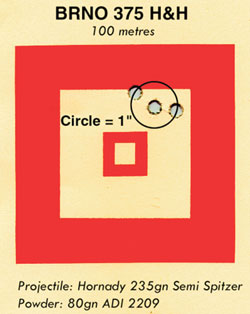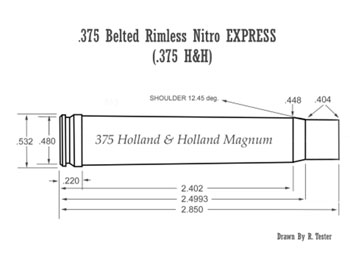The 375 H&H turns 90
by Ric Tester
The .375 H&H Magnum is a colossus among cartridges. Introduced by the British firm of Holland and Holland in 1912, this essentially African round quickly established itself at the top of the heap in terms of its great versatility and reliability. Now, some 90 years on, the .375 is chambered by more manufacturers of big game rifles than any other cartridge - a testimony to its universal appeal.
 The history of the .375 H&H dates back to the beginning of the last
century, when the 9.5mm Mannlicher-Schoenauer became popular as a
large/medium bore round - suitable, albeit marginally, for the tougher
African game. Holland and Holland introduced its .400/375 in 1905 in an
attempt to capture its share of the market and compete with the already
established Mannlicher.
The history of the .375 H&H dates back to the beginning of the last
century, when the 9.5mm Mannlicher-Schoenauer became popular as a
large/medium bore round - suitable, albeit marginally, for the tougher
African game. Holland and Holland introduced its .400/375 in 1905 in an
attempt to capture its share of the market and compete with the already
established Mannlicher.
The .400/375 is historic in that it was the first ever ‘belted’ cartridge. The belt was added in order to produce the correct head-space without the use of a rim or by relying solely upon the shoulder. The cartridge was not widely accepted by hunters who complained that its 270-grain bullet lacked penetration and did not hold together well enough to be truly effective on large and potentially dangerous species. Furthermore, the development and release of the superior 9.3x62 Mauser in 1905 virtually buried the .400/375, as its higher bullet velocity and greater sectional density guaranteed greater penetration and stopping power. Mauser produced reliable and relatively inexpensive rifles for its round and for a while it ruled the roost as a general all-around African cartridge.
All that changed in 1912 when Holland and Holland introduced its ‘.375 Belted Rimless Nitro Express’ (375 H&H). The engineers at Holland and Holland had thoughtfully planned to produce a cartridge that would not only have sufficient velocity to transmit the necessary ‘shock’ in order to ensure a quick kill, but would also have sufficient power of penetration to reach the vitals of the biggest game animal. The belt of the earlier .400/375 was retained and the cartridge was stretched to the maximum length allowable by the Mauser action. The 300-grain bullet could be launched at 2500fps, giving it a muzzle energy of 4170ft/lbs, which was sufficient to garner the interest of the African big game hunters who reported that it was quick to dispatch elephant, buffalo or rhino - provided of course that the hunter did his part. John ‘Pondoro’ Taylor, one of the great hunters of dangerous African species, had these comments to make about the 375 H&H:
“Undoubtedly one of the deadliest weapons in existence.
“It would be difficult to see how the .375 Magnum could fail to give satisfaction for any kind of big game hunting.
“Only those who have actually used this cartridge on a wide variety of different animals, having previously used ordinary rifles on those same species, are in a position to thoroughly appreciate the .375 Magnum’s deadliness.”
Holland and Holland chose to release their design to the firearms industry after its introduction and British manufacturers were quick to chamber rifles for the big .375. In 1926, the first cartridges became commercially available in the United States, although rifles for the calibre would not be manufactured by Winchester for another 11 years.
Apart from being suitable for all African and Asian game, the cartridge found great favour in the United States - its 270-grain soft point projectile proving more than enough for North American species, including the Alaskan bears. With increasing numbers of Americans making the pilgrimage to Africa and a developing interest in large calibre rifles, the future of the .375 was assured. Its popularity was buoyed by the availability of relatively inexpensive ammunition and the fact that all major rifle manufacturers in the USA and many in Britain and Europe were chambering rifles for it.
 Here in the great southern land, the Big .375 is really too much gun
for all but the largest animals, although professional buffalo hunting
guides in the northern parts of Australia report that the .375 is the
most frequently encountered rifle among their clients. Here the calibre
is used for buffalo, scrub bull and wild boar.
Here in the great southern land, the Big .375 is really too much gun
for all but the largest animals, although professional buffalo hunting
guides in the northern parts of Australia report that the .375 is the
most frequently encountered rifle among their clients. Here the calibre
is used for buffalo, scrub bull and wild boar.
The .375 is a powerful, flat-shooting cartridge. Loaded with the Speer Hot Core 235-grain semi-spitzer, muzzle velocities of about 2900fps can be obtained. At this velocity, the retained energy at 300 yards is a staggering 2250ft/lbs and at a 300-yard zero, the rise at 200 yards is only 5.5 inches. The slightly more massive Speer 270-grain boattail can be loaded to velocities exceeding 2700fps and when zeroed at 200 yards, will rise a mere two inches halfway to the target. For heavier, charge-stopping loads, a 300-grain solid or full metal jacket can be launched at 2500fps. Shooters have a luxury of choice in terms of bullet selection, with an extensive range of projectiles currently available on the market.
All major firearms manufacturers produce rifles in .375 H&H. Some popular makes include the Remington 700 in stainless steel, the Winchester model 70 and the Savage 116 ‘Safari Express’. Sturm Ruger & Company has a .375 chambering for both their model 77 and also their famous ‘Ruger Number 1’. (A stainless steel version of the #1 should be available soon.) Weatherby and Browning have also manufactured .375s. An avid fan of the .375 myself, I currently own a BRNO (CZ) ZKK-602 and a Sako 75. Both rifles have been glass bedded and scoped and are capable of fine accuracy, with three-shot groups within 1.5MOA at 100 metres being pretty much the norm. The strong CZ action has been used by a number of US gunsmiths as a basis upon which to build expensive custom made and limited edition rifles that feature intricate engraving and high quality finishes.
![]() For many years, the cartridge itself has been the starting point from
which numerous other big game cartridges have evolved. Holland and
Holland introduced their .275 and .300 magnums in 1913 and 1925
respectively, both derivatives of the original .375. American
manufacturers have created a tremendous variety of cartridges - belted
magnums - that are either first- or second-generation descendents from
Holland and Holland’s 1912 magnum. Some of these include the .458,
.338, .300, .264 Winchester Magnums, 8mm, 7mm and 6.5mm Remington
Magnums and the .416 Remington Magnum. Wildcatters have also
experimented with the .375 - in one instance necking it up to .458
calibre to produce the ominous .450 Watts.
For many years, the cartridge itself has been the starting point from
which numerous other big game cartridges have evolved. Holland and
Holland introduced their .275 and .300 magnums in 1913 and 1925
respectively, both derivatives of the original .375. American
manufacturers have created a tremendous variety of cartridges - belted
magnums - that are either first- or second-generation descendents from
Holland and Holland’s 1912 magnum. Some of these include the .458,
.338, .300, .264 Winchester Magnums, 8mm, 7mm and 6.5mm Remington
Magnums and the .416 Remington Magnum. Wildcatters have also
experimented with the .375 - in one instance necking it up to .458
calibre to produce the ominous .450 Watts.
In terms of cartridge design, it is interesting to note that most of the more recent entrants into the big game stakes are of the beltless variety. These cartridges are based on another old-timer - the .404 Jeffery and include such monsters as the .300 Remington Ultra Magnum, the .330 Dakota and the .416 Dakota. According to the manufacturers, the ‘new’ beltless cartridges show an improved degree of accuracy due to better bore alignment and more uniform powder burning rates in addition to smoother functioning through a magazine. Will this mean the decline and eventual demise of the celebrated .375 H&H magnum? I think not, at least not in the short term anyway. For longevity of a cartridge becomes its own recommendation.
In the case of the .375 Magnum, there is much to recommend:
- versatility
- stopping power
- accuracy.
For those shooters who wish to add a heavy calibre rifle to their collection, look no further than the superb .375 H&H.
